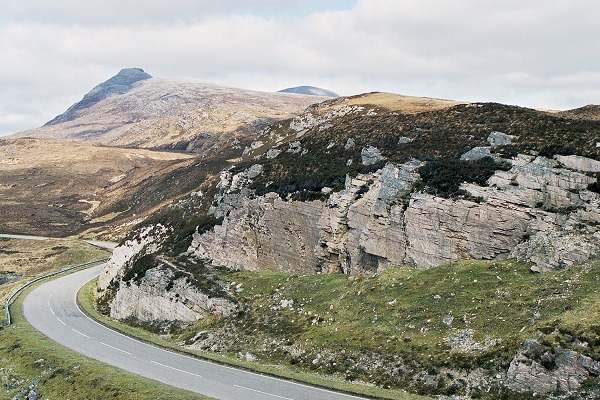
| Home | Geological History | Stratigraphy | Area map | Rock Index | About |
| Scourie | Achmelvich | Laxford | Clachtoll | Stoer | Assynt | Skiag Bridge | Glencoul | Knockan | Borralan | Ledmore |
The Cambrian sedimentary succession is very well displayed in road-cuts along the north shore of Loch Assynt near the Skiag Bridge road junction. The Cambrian basal quartzite lies on the Torridonian sandstones with an angular unconformity that cannot be seen directly on the road but is easily deduced from the different orientations of the bedding: the Torridonian is almost horizontal, but the Cambrian rocks dip to the east at about 14 degrees. All the Cambrian rock types are exposed on the road, up to the grey dolomitic limestone at the bottom of the Durness Limestone. At this level the Sole Thrust, the lowest thrust fault in the Moine Thrust zone, is found. Here there is a remarkable stack of thin slices, known as an imbricate zone, in which the Cambrian rock types (Fucoid Beds, Salterella Grit and grey limestone) are repeated over and over again like a shuffled pack of cards. Imbricate zones like this are now known from many other thrust zones.
The three views below were taken from the same spot near the shore of Loch Assynt

![]() This view to the north-west shows the hard, white basal
quartzite of the Cambrian succession. It can be followed
from the roadcut in the foreground all the way up the ridge
to the summit in the distance (Spidean Coinich), dipping
gently to the right. It lies with an angular unconformity
on the red Torridonian sandstones, whose horizontal strata
are just visible on the left, in the distance.
This view to the north-west shows the hard, white basal
quartzite of the Cambrian succession. It can be followed
from the roadcut in the foreground all the way up the ridge
to the summit in the distance (Spidean Coinich), dipping
gently to the right. It lies with an angular unconformity
on the red Torridonian sandstones, whose horizontal strata
are just visible on the left, in the distance.
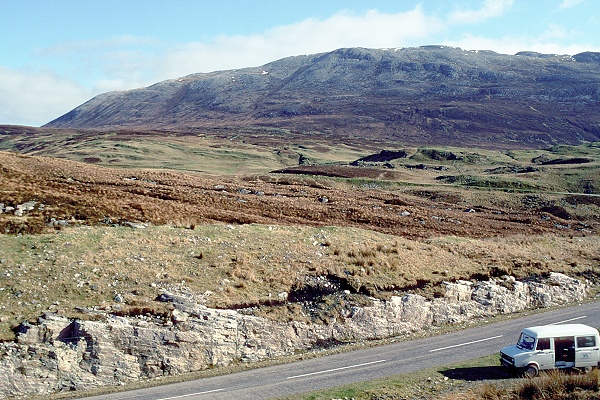
![]() This view is to the north-east. The boundary between the
basal quartzite and the Pipe Rock is located in the
road-cut at bottom left. The green, ridged slopes in the
middle distance are underlain by the Fucoid Beds.
Immediately above these is the Sole Thrust and the
imbricate zone, the package of thin thrust slices. The
ridge in the background is made of quartzite and gneiss in
the overlying thrust sheets.
This view is to the north-east. The boundary between the
basal quartzite and the Pipe Rock is located in the
road-cut at bottom left. The green, ridged slopes in the
middle distance are underlain by the Fucoid Beds.
Immediately above these is the Sole Thrust and the
imbricate zone, the package of thin thrust slices. The
ridge in the background is made of quartzite and gneiss in
the overlying thrust sheets.
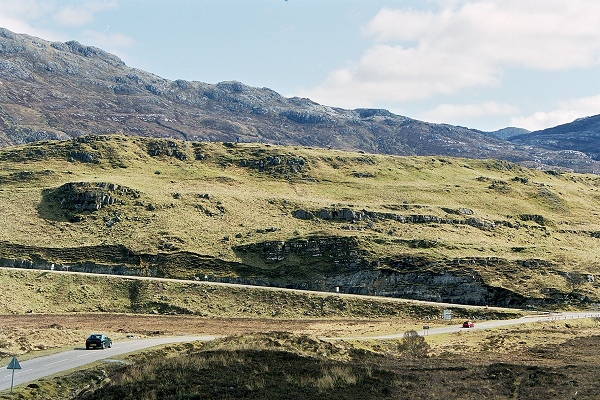
![]() This view shows the upper part of the Cambrian succession
at Skiag Bridge, from the Pipe Rock to the lower part of
Durness Limestone, in the green slopes above the road. The
prominent outcrop halfway up the green slope is the
Salterella Grit. The higher ridge behind is made of
gneisses in the Moine Thrust zone.
This view shows the upper part of the Cambrian succession
at Skiag Bridge, from the Pipe Rock to the lower part of
Durness Limestone, in the green slopes above the road. The
prominent outcrop halfway up the green slope is the
Salterella Grit. The higher ridge behind is made of
gneisses in the Moine Thrust zone.
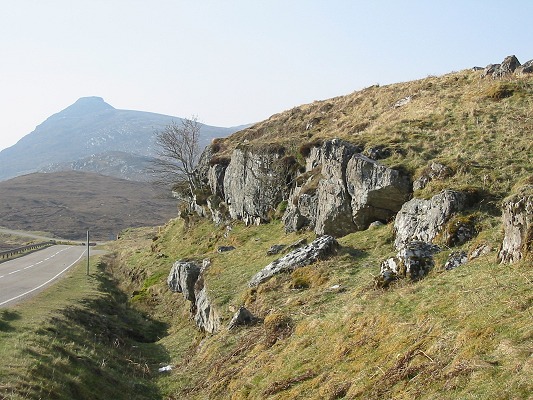
![]() This small crag marks the outcrop of the Salterella Grit
at the roadside.
This small crag marks the outcrop of the Salterella Grit
at the roadside.
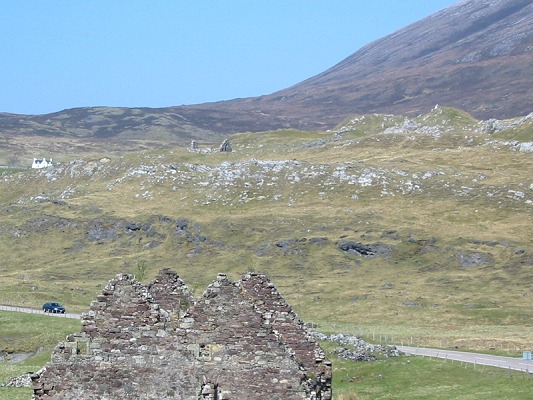
![]() The lower part of the Durness limestone is dark grey, but
rocks higher up the limestone succession are distinctly
lighter in colour. Here, in the lower part of the Moine
Thrust zone near Skiag Bridge, we see white limestones
overlying grey ones in the slopes between Calda House (the
ruin in the foreground) and Achmore farm (left, on the
hillside in the distance).
The lower part of the Durness limestone is dark grey, but
rocks higher up the limestone succession are distinctly
lighter in colour. Here, in the lower part of the Moine
Thrust zone near Skiag Bridge, we see white limestones
overlying grey ones in the slopes between Calda House (the
ruin in the foreground) and Achmore farm (left, on the
hillside in the distance).
|
Quartz sandstone (orthoquartzite), Cambrian Loch Assynt |
|
Quartz sandstone with vertical burrows, Cambrian Pipe Rock Loch Assynt |
|
Calcareous siltstone, Cambrian Fucoid Beds Loch Assynt |
|
Impure quartz sandstone, Cambrian Salterella Grit Loch Assynt |
|
Impure quartz sandstone with small shelly fossils, Cambrian Salterella Grit Loch Assynt |
|
Grey dolomitic limestone, Cambrian Durness Limestone Loch Assynt |
| Scourie | Achmelvich | Laxford | Clachtoll | Stoer | Assynt | Skiag Bridge | Glencoul | Knockan | Borralan | Ledmore |
| Home | Geological History | Stratigraphy | Area map | Rock Index | About |
D.J. Waters, Department of Earth Sciences, May 2003